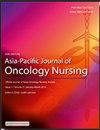Feasibility and preliminary efficacy of a systematic transaction model-guided dyadic coping nursing intervention for patients with breast cancer and their spousal caregivers: A pilot study
IF 2.4
3区 医学
Q1 NURSING
引用次数: 0
Abstract
Objective
This study aimed to assess the feasibility, acceptability, and preliminary efficacy of a Systematic Transaction Model (STM)-guided dyadic coping nursing intervention for patients with breast cancer and their spouses.
Methods
A single-arm, pre-test/post-test pilot study was conducted at a tertiary hospital in Wuxi, China, recruiting 28 breast cancer patient–caregiver pairs. Each dyad participated in six hybrid intervention sessions. Paired t-tests were used to evaluate pre- and post-intervention changes, and effect sizes were calculated. Feasibility was assessed by recruitment and retention rates, acceptability via the Client Satisfaction Questionnaire-8 (CSQ-8), and preliminary efficacy through measures of body image, dyadic coping, post-traumatic growth, and marital satisfaction.
Results
All 28 dyads completed the intervention. Patients showed small-to-moderate improvements in body image, post-traumatic growth, dyadic coping, and marital satisfaction (d = 0.4–0.5, P ≤ 0.022), with clinically meaningful changes observed in 39%–68% of patients. Spousal caregivers also demonstrated improvements in post-traumatic growth, dyadic coping, and marital satisfaction (d = 0.3–0.6, P ≤ 0.033), with 36%–46% showing clinically important differences.
Conclusions
This pilot study supports the feasibility and initial efficacy of an STM-guided dyadic coping intervention, which may benefit breast cancer patients and their spouses as a unit. Further large-scale trials are recommended to validate these findings.
Trial registration
China Clinical Trial Registry (ChiCTR2400083416).
系统交易模型指导的二元应对护理干预乳腺癌患者及其配偶照顾者的可行性和初步效果:一项试点研究。
目的:探讨以系统交易模型(system Transaction Model, STM)为指导的二元应对护理干预乳腺癌患者及其配偶的可行性、可接受性及初步效果。方法:在中国无锡某三级医院进行单臂、测试前/测试后试点研究,招募28对乳腺癌患者-护理者。每个二人组参加了六次混合干预。采用配对t检验评价干预前后的变化,并计算效应量。通过招募率和保留率来评估可行性,通过客户满意度问卷-8 (CSQ-8)来评估可接受性,并通过身体形象、二元应对、创伤后成长和婚姻满意度来评估初步效果。结果:28对患者均完成干预。患者在身体形象、创伤后成长、二元应对和婚姻满意度方面均有小到中度的改善(d = 0.4 ~ 0.5, P≤0.022),39% ~ 68%的患者有临床意义的改善。配偶照顾者在创伤后成长、双重应对和婚姻满意度方面也有改善(d = 0.3-0.6, P≤0.033),其中36%-46%具有临床重要差异。结论:本初步研究支持stm引导的二元应对干预的可行性和初步效果,可能使乳腺癌患者及其配偶作为一个整体受益。建议进一步进行大规模试验来验证这些发现。试验注册:中国临床试验注册中心(ChiCTR2400083416)。
本文章由计算机程序翻译,如有差异,请以英文原文为准。
求助全文
约1分钟内获得全文
求助全文
来源期刊

Asia-Pacific Journal of Oncology Nursing
Multiple-
CiteScore
2.80
自引率
11.10%
发文量
136
审稿时长
31 days
 求助内容:
求助内容: 应助结果提醒方式:
应助结果提醒方式:


